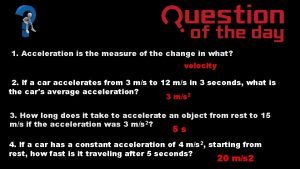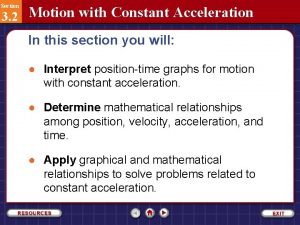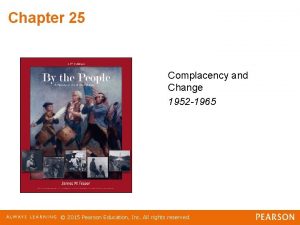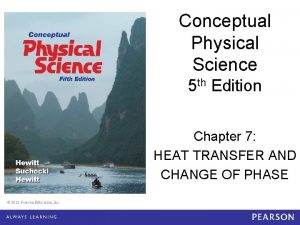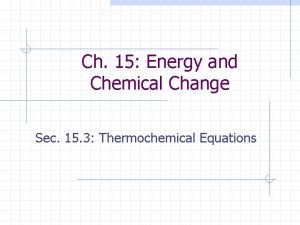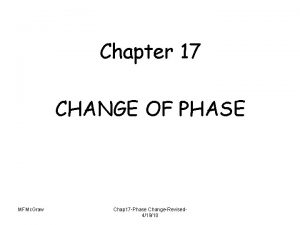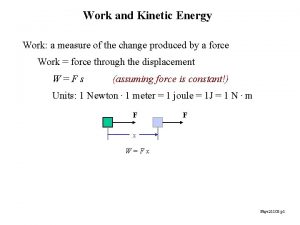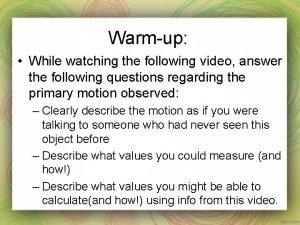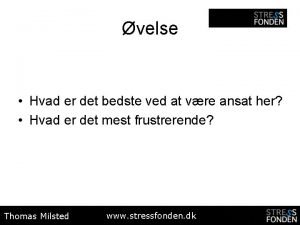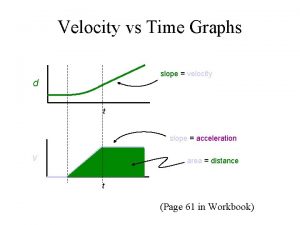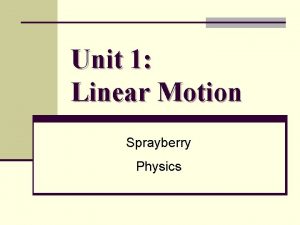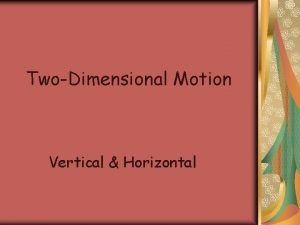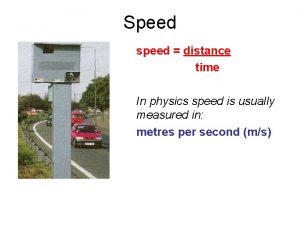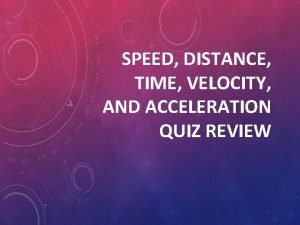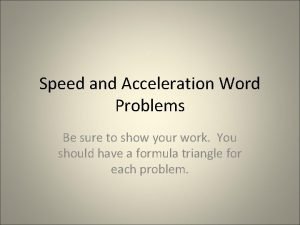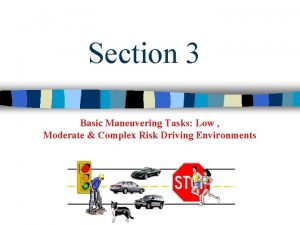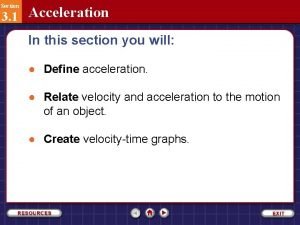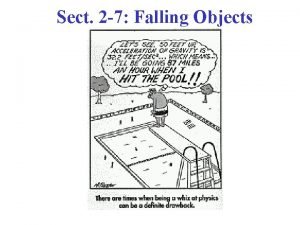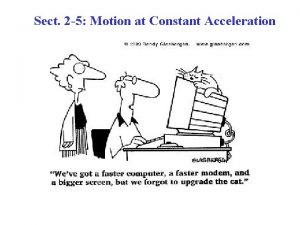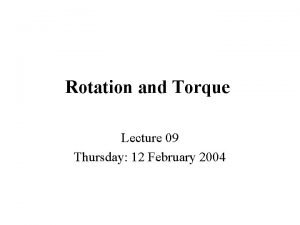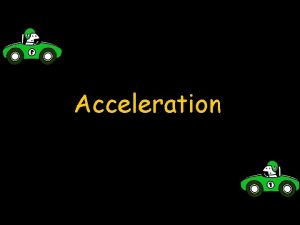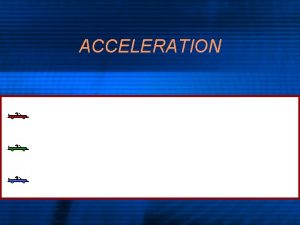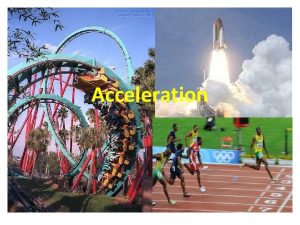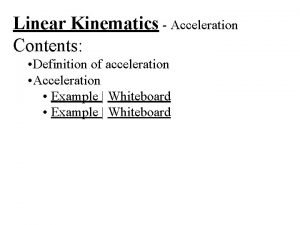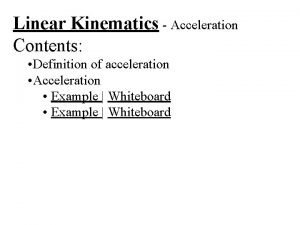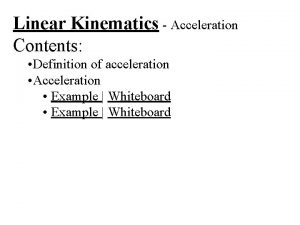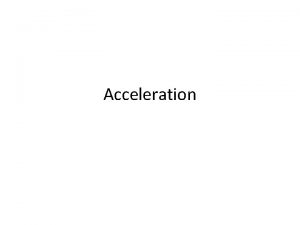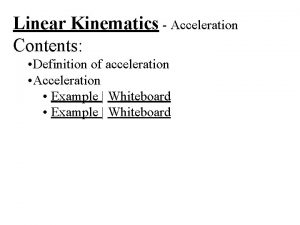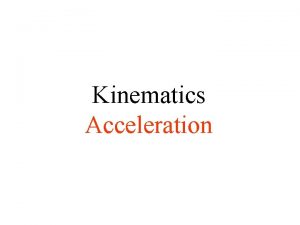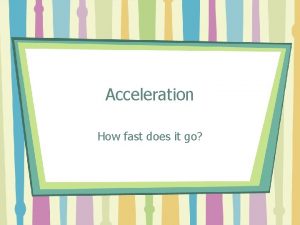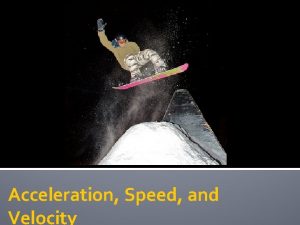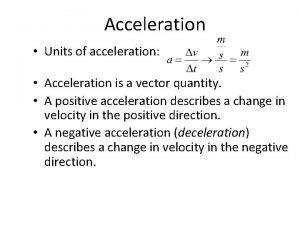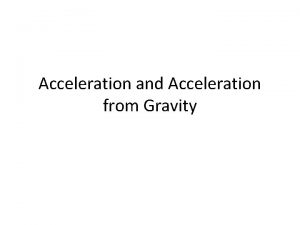Chapter 4 ACCELERATION What is Acceleration Acceleration change










































































- Slides: 74

Chapter 4 ACCELERATION

What is Acceleration? Acceleration: change in velocity over the time interval over which it occurred

Average Acceleration Average acceleration is the ratio of change in velocity over change in time. v – v Δv 2 1 a= = t 2 – t 1 Δt

Average Acceleration Example: The velocity of a car increases from 2. 0 m/s at 1. 0 s to 16 m/s at 4. 5 s. What is the car’s average acceleration? 16 m/s – 2. 0 m/s 14 m/s 2 4. 5 s – 1. 0 s 3. 5 s = = 4 m/s a=

Average Acceleration Example: A car goes faster and faster backwards down a long driveway. We define forward velocity as positive, so backward velocity is negative. The car’s velocity changes from -2. 0 m/s to -9. 0 m/s in a 2. 0 -s time interval. Find the acceleration.

Average Acceleration Solution: velocity change, Δv = -9. 0 m/s – (-2. 0 m/s) = -7. 0 m/s average acceleration = Δv / Δt = -7. 0 m/s / 2 s = -3. 5 m / s^2

Average acceleration vs. Instantaneous acceleration Average acceleration is calculated over a time interval. Instantaneous acceleration occurs at a specific time.

Average Acceleration on Velocitytime graph Slope of the line = average acceleration Δv Δt

Instantaneous Acceleration on Velocity-time graph The slope of the tangent to the curve is the instantaneous acceleration for the object at the specified time, t. v t

Constant Acceleration that does not change in time is uniform or constant acceleration. It is represented by a straight line on a velocity-time graph.

Constant Acceleration vf = vi + at vi Slope = a t

Constant Acceleration Example: If a car with a velocity of 2. 0 m/s at t = 0 accelerates at a rate of +4. 0 m/s^2 for 2. 5 s, what is its velocity at time t = 2. 5 s? Using the equation of constant acceleration: vf = vi + at = +2. 0 m/s + (+4. 0 m/s 2)(2. 5 s) = 12 m/s

Displacement when velocity and time are known Average velocity: v = ½ (vf + vi) Average velocity: v = d/t Combining the two equations d/t = ½ (vf + vi) d = ½ (vf + vi) t

Displacement when acceleration and time are known Starting with the displacement equation: d = ½ (vf + vi) t and using the final velocity equation: vf = vi + at Combining the two equations: d = ½ (vi + at + vi) t = ½ (2 vi + at) t d = vit + ½ at 2

Displacement when velocity and acceleration are known Starting with d = ½ (vf + vi) t and vf = vi + at Substituting t = (vf – vi)/a into d = ½ (vf + vi) t d = ½ (vf + vi) (vf – vi) /a = (vf 2 – vi 2) / 2 a Solve for vf 2: vf 2 = vi 2 + 2 ad

Equations of Motion for Uniform Acceleration Equations Variables vf = vi + at vi vf a t d = ½ (vf + vi) t vi vf d t d = vit + ½ at 2 vi a d t vf vi vf a d 2 = vi 2 + 2 ad

Example: What is the displacement of a train as it is accelerated uniformly from +11 m/s to +33 m/s in a 20. 0 -s interval?

Example: A car starting from rest accelerates uniformly at +6. 1 m/s 2 for 7. 0 s. How far does the car move?

Example: An airplane must reach a velocity of 71 m/s for takeoff. If the runway is 1. 0 km long, what must the constant acceleration be?

Example: The time the Demon Drop ride at Cedar Point, Ohio is freely falling for 1. 5 s. a. What is the velocity at the end of this time? b. How far does it fall?

Problems 1. Find the uniform acceleration that causes a car’s velocity to change from 32 m/s to 96 m/s in an 8. 0 -s period. 96 m/s – 32 m/s = 8. 0 m/s^2 8. 0 s

Problems 2. Rocket-powered sleds are used to test the responses of humans to acceleration. Starting from rest, one sled can reach a speed of 444 m/s in 1. 80 s and can be brought to a stop again in 2. 15 s.

Problems a. Calculate the acceleration of the sled when starting and compare it to the acceleration due to gravity, 9. 80 m/s 2. a = 444 m/s – 0 = 247 m/s 2 1. 80 s 247 / 9. 8 = 25. 2

Problems b. Find the acceleration of the sled when braking and compare it to the magnitude of the acceleration due to gravity. a = 0 – 444 m/s = - 207 m/s 2 2. 15 s 207 m/s 2 = 21. 1 9. 8 m/s 2

Problems Velocity m/s 3. Find the acceleration of the moving object. 30 20 5 10 Time s 20 25

Problems a. During the first five seconds of travel. a = 30 m/s – 0 m/s = 6 m/s 2 5 s b. Between the fifth and the tenth second of travel. a. 30 m/s – 30 m/s = 0 5 s

Problems c. Between the tenth and the fifteenth second of travel. a = 20 m/s – 30 m/s = -2 m/s 2 5 s d. Between the twentieth and the twentyfifth second of travel. a = 0 – 20 m/s = -4 m/s 2 5 s

Problems 4. Position-time graph d d d t a t b c t

Problems a. Velocity-time graphs v v 0 t a b t 0 t c

Problems b. Acceleration-time graphs a a a t a 0 b t 0 t c

Problems 5. A car with a velocity of 22 m/s is accelerated uniformly at the rate of 1. 6 m/s^2 for 6. 8 s. What is its final velocity? vf = vi + at = 22 m/s + (1. 6 m/s 2)(6. 8 s) = 33 m/s

Problems 6. The velocity of an automobile changes over an 8. 0 -s time period as shown. time velocity 0. 0 5. 0 20. 0 1. 0 4. 0 6. 0 20. 0 2. 0 8. 0 7. 0 20. 0 3. 0 12. 0 8. 0 20. 0 4. 0 16. 0

Problems a. Plot the velocity-time graph of the motion. 20 16 12 8 4 2 4 6 8

Problems b. Determine the displacement of the car the first 2. 0 s. (displacement is the area under the curve) d = ½ bh = ½ (2. 0 s)(8. 0 m/s – 0) =8 m

Problems c. What displacement does the car have during the first 4. 0 s? d = ½ bh = ½ (4. 0 s)(16. 0 m/s – 0) = 32 m

Problems d. What displacement does the car have during the entire 8. 0 s? d = ½ bh + bh = ½ (5. 0 s)(20. 0 m/s – 0) + (8. 0 s – 5. 0 s)(20. 0 m/s) = 110 m

Problems e. Find the slope of the line between t = 0 s and t = 4. 0 s. What does this slope represent? a = Δv/ Δt = (16 m/s – 0 m/s)/(4. 0 s – 0 s) = 4 m/s 2

Problems f. Find the slope of the line between t = 5. 0 s and t = 7. 0 s. What does this slope indicates. a = Δv/ Δt = (20 m/s – 20 m/s)/(7. 0 s – 5. 0 s) = 0 constant velocity

Problems 7. Figure 4 -20 shows the position-time and velocity-time graphs of a karate expert using a fist to break wooden boards.

Problems 7 a. Use the velocity-time graph to describe the motion of the expert’s fist during the first 10 ms. The fist moves downward at about 13 m/s for about 5 ms. It then suddenly comes to a halt (accelerates).

Problems 7 b. Estimate the slope of the velocity-time graph to determine the acceleration of the fist when it suddenly stops. a = Δv/ Δt = (0 – (-13 m/s))/(7. 5 ms – 5. 0 ms)) = 5200 m/s 2

Problems 7 c. Express the acceleration as a multiple of the gravitational acceleration, g = 9. 8 m/s^2. (5200 m/s^2)/(9. 8 m/s^2) = 530

Problems 7 d. Determine the area under the velocitytime curve to find the displacement of the fist in the first 6 ms. Compare with the position-time graph. The area is almost rectangular: (-13 m/s)(0. 006 s) = -8 cm. This is in agreement with the position-time graph where the hand moves from +8 cm to 0 cm, for a net displacement of – 8 cm.

Problems 8. A supersonic jet flying at 145 m/s is accelerated uniformly at the rate of 23. 1 m/s^2 for 20 s.

Problems 8 a. What is its final velocity? s) vf = vi + at = 145 m/s + (23. 1 m/s^2)(20. 0 = 607 m/s

Problems b. The speed of sound in air is 331 m/s. How many times the speed of sound is the plane’s final speed? x = (607 m/s) / (331 m/s) = 1. 83 times the speed of sound

Problems 9. Determine the final velocity of a proton that has an initial velocity of 2. 35 x 10^5 m/s and then is accelerated uniformly in an electric field at the rate of -1. 10 x 10^12 m/s^2 for 1. 50 x 10^-7 s. vf = vi + at = 235 m/s + (-1. 10 x 10^12 m/s^2 )(1. 50 x 10^-7 s) = 7. 0 x 10^4 m/s

Problems 10. Determine the displacement of a plane that is uniformly accelerated from 66 m/s to 88 m/s in 12 s. d = (vf + vi)t / 2 = (88 m/s + 66 m/s)(12 s) / 2 = 924 m

Problems 11. How far does a plane fly in 15 s while its velocity is changing from +145 m/s to +75 m/s at a uniform rate of acceleration? d = (vf + vi)t / 2 = (75 m/s + 145 m/s)(15 s) / 2 = 1650 m

Problems 12. A car moves at 12 m/s and coasts up a hill with a uniform acceleration of -1. 6 m/s^2.

Problems a. How far has the car traveled after 6. 0 s? d = vit + ½ at^2 = (12 m/s)(6 s) + ½ (-1. 6 m/s)(6. 0)^2 = 43 m b. How far has it gone after 9. 0 s? d = vit + ½ at^2 = (12 m/s)(9 s) + ½ (-1. 6 m/s)(9. 0)^2

Problems 13. Four cars start from rest. Car A accelerates at 6. 0 m/s^2, car b at 5. 4 m/s^2, car C at 8. 0 m/s^2, and car D at 12 m/s^2.

Problems 13 (a and b) Velocities of cars at the end of 2 s. Car A B C D velocity (m/s) 12 11 16 24 displacement (m) 12 11 16 24

Problems 13 c. What conclusions do you reach about the velocity attained and the displacement of a body starting from rest at the end of the first 2. 0 s of acceleration? The displacement traveled and velocity attained are numerically the same at the end of two seconds.

Problems 14. An astronaut drops a feather from 1. 2 m above the surface of the moon. If the acceleration of gravity on the moon is 1. 62 m/s^2, how long does it take the feather to hit the surface?

Problems 14. d = vit + ½ at^2 t = √(2 d/g) = √((2)(-1. 2 m)/(-1. 6 m/s 2)) = 1. 2 s

Problems 15. Table 4 -4 is a table of displacement and velocities of a ball at the end of each second for the first 5. 0 s of free fall from rest. time displacement velocity 0. 0 1. 0 -4. 9 -9. 8 2. 0 -19. 6 3. 0 -44. 1 -29. 4 4. 0 -78. 4 -39. 2 5. 0 -122. 5 -49. 0

Problems 15 a. Use the data in the table to plot a velocity-time graph 0 Velocity -50 Time 5. 0

Problems 15 b. Use the data in the table to plot a position-time graph. 0 Position -122. 5 Time 5. 0

Problems 15 c. Find the slope of the curve at the end of 2. 0 and 4. 0 s on the position-time graph. What are the approximate slopes? Do these values agree with the table of velocity? at 2. 0 s: slope = (-40 – (-1))/(3. 0 – 1. 0) = -20 m/s at 4. 0 s: slope = (-118 – (-40))/(5. 0 – 3. 0) = -39 m/s Yes, the values agree.

Problems 15 d. Use the data in the table to plot a position versus time-squared graph. What time of curve is obtained? A straight line 0 -122. 5 Time^2 25

Problems 15 e. Find the slope of the line at any point. Explain the significance of the value you obtain. slope = (-122. 5 – 0)/(25 – 0) = -4. 9 m/s^2 The slope is ½ g

Problems 15 f. Does this curve agree with the equation d = ½ gt^2? yes, since it is a straight line y = mx + b where y is d, m is ½ g, x is t^2 and b is 0.

Problems 16. A plane travels 5. 0 x 10^2 m while being accelerated uniformly from rest at the rate of 5. 0 m/s^2. What final velocity does it attain? vf ^2 = vi^2 + 2 ad vf = √(vi^2 + 2 ad) = √(0^2+ 2(5. 0)(500)) = 71 m/s

Problems 17. A race car can be slowed with a constant acceleration of -11 m/s 2. a. If the car is going 55 m/s , how many meters will it take to stop? b. Repeat for a car going 110 m/s.

17 a. vf 2 = vi 2 + 2 ad d = (vf 2 – vi 2)/2 a = (0 – 552)/(2*-11) = 137 m

17 b. vf 2 = vi 2 + 2 ad d = (vf 2 – vi 2)/2 a = (0 – 1102)/(2*-11) = 550 m

25 a. Determine if the car hits the barrier. d = 50 meters, it hits the barrier 25 b. V = 22 m/s

26 a.

26 b. 26 c. Slope = 0. 083 s 2/m 1/slope = 12 m/s 2 26 d. Yes, -6 m/s 2

28 a. Dcar = 150 meters 28 b. vf = 42 m/s

29 a. 29 b. yes

33 a. vf = -15 m/s 33 b. d = -10 m

34 a. vf = -25 m/s 34 b. d = -30 m 34 c. The helicopter has fallen -10 m and the bag is 20 m below the helicopter 34 d. The bag is 20 m below the helicopter after 2 s.
 Circular acceleration
Circular acceleration Relationship between angular and linear quantities
Relationship between angular and linear quantities Radial acceleration formula
Radial acceleration formula Angular acceleration and linear acceleration
Angular acceleration and linear acceleration Tangential acceleration and centripetal acceleration
Tangential acceleration and centripetal acceleration Acceleration is the measure of the change in
Acceleration is the measure of the change in Is mashing potatoes a chemical change
Is mashing potatoes a chemical change Physical change examples
Physical change examples Absolute change and relative change formula
Absolute change and relative change formula Integer
Integer Whats the difference between a chemical and physical change
Whats the difference between a chemical and physical change Decrease in supply vs decrease in quantity supplied
Decrease in supply vs decrease in quantity supplied Supply and demand curve shifts
Supply and demand curve shifts Enagic comp plan
Enagic comp plan Proactive vs reactive change
Proactive vs reactive change Physical change
Physical change Spare change physical versus chemical change
Spare change physical versus chemical change Rocks change due to temperature and pressure change
Rocks change due to temperature and pressure change Whats the difference between physical and chemical changes
Whats the difference between physical and chemical changes How does a physical change differ from a chemical change
How does a physical change differ from a chemical change What is an example of physical change
What is an example of physical change First-order and second-order change examples
First-order and second-order change examples Is a magnet sticking to the refrigerator a chemical change
Is a magnet sticking to the refrigerator a chemical change Climate change 2014 mitigation of climate change
Climate change 2014 mitigation of climate change Chapter 2 motion section 3 acceleration answers
Chapter 2 motion section 3 acceleration answers Section 2 acceleration answer key
Section 2 acceleration answer key Turmoil and change in mexico
Turmoil and change in mexico Chapter 14 the sixties a decade of protest and change
Chapter 14 the sixties a decade of protest and change Chemistry matter and change chapter 7
Chemistry matter and change chapter 7 Chemistry matter and change chapter 10 the mole answer key
Chemistry matter and change chapter 10 the mole answer key Chapter 3 section 3 constitutional change by other means
Chapter 3 section 3 constitutional change by other means Chapter 25 complacency and change
Chapter 25 complacency and change Chapter 14 section 1 fossil evidence of change study guide
Chapter 14 section 1 fossil evidence of change study guide Chapter 1 review matter and change
Chapter 1 review matter and change Chapter 23 change of phase
Chapter 23 change of phase Atmosphere
Atmosphere Chapter 7 heat transfer and change of phase
Chapter 7 heat transfer and change of phase Chemistry matter and change chapter 7
Chemistry matter and change chapter 7 Chemistry matter and change chapter 6
Chemistry matter and change chapter 6 Chemistry matter and change chapter 10 the mole answer key
Chemistry matter and change chapter 10 the mole answer key Chapter 27 tradition and change in east asia
Chapter 27 tradition and change in east asia Chapter 27 tradition and change in east asia
Chapter 27 tradition and change in east asia Chapter 26 tradition and change in east asia
Chapter 26 tradition and change in east asia Chemistry matter and change chapter 2 answer key
Chemistry matter and change chapter 2 answer key Organizational change and stress management
Organizational change and stress management Chapter 15 energy and chemical change
Chapter 15 energy and chemical change Chapter 13 atmosphere and climate change
Chapter 13 atmosphere and climate change Chapter 27 tradition and change in east asia
Chapter 27 tradition and change in east asia Conceptual physics chapter 17 change of phase answers
Conceptual physics chapter 17 change of phase answers Circle the solute and underline the solvent
Circle the solute and underline the solvent Chapter 13 managing change and innovation
Chapter 13 managing change and innovation Chapter 23 activity: coping with change, 1920-1929
Chapter 23 activity: coping with change, 1920-1929 The calm waters metaphor
The calm waters metaphor Chapter 14 a new spirit of change
Chapter 14 a new spirit of change Kinetic energy acceleration
Kinetic energy acceleration Angular acceleration symbol
Angular acceleration symbol Juniper wan optimization
Juniper wan optimization Acceleration af social forandring
Acceleration af social forandring Constant leftward velocity
Constant leftward velocity A bowling ball rolled with a force of 15n
A bowling ball rolled with a force of 15n What is the difference between velocity and acceleration
What is the difference between velocity and acceleration Example of vertical motion of galileo
Example of vertical motion of galileo Translational motion diagram
Translational motion diagram Centripetal acceleration unit
Centripetal acceleration unit Tangential vs centripetal acceleration
Tangential vs centripetal acceleration Velocity and acceleration difference
Velocity and acceleration difference Acceleration
Acceleration Speed time distance triangle
Speed time distance triangle Velocity=distance/time
Velocity=distance/time A bullet travels at 850 m/s
A bullet travels at 850 m/s Acceleration lane
Acceleration lane Section 3 acceleration
Section 3 acceleration As an object freely falls its
As an object freely falls its M
M Radial component of linear acceleration
Radial component of linear acceleration





